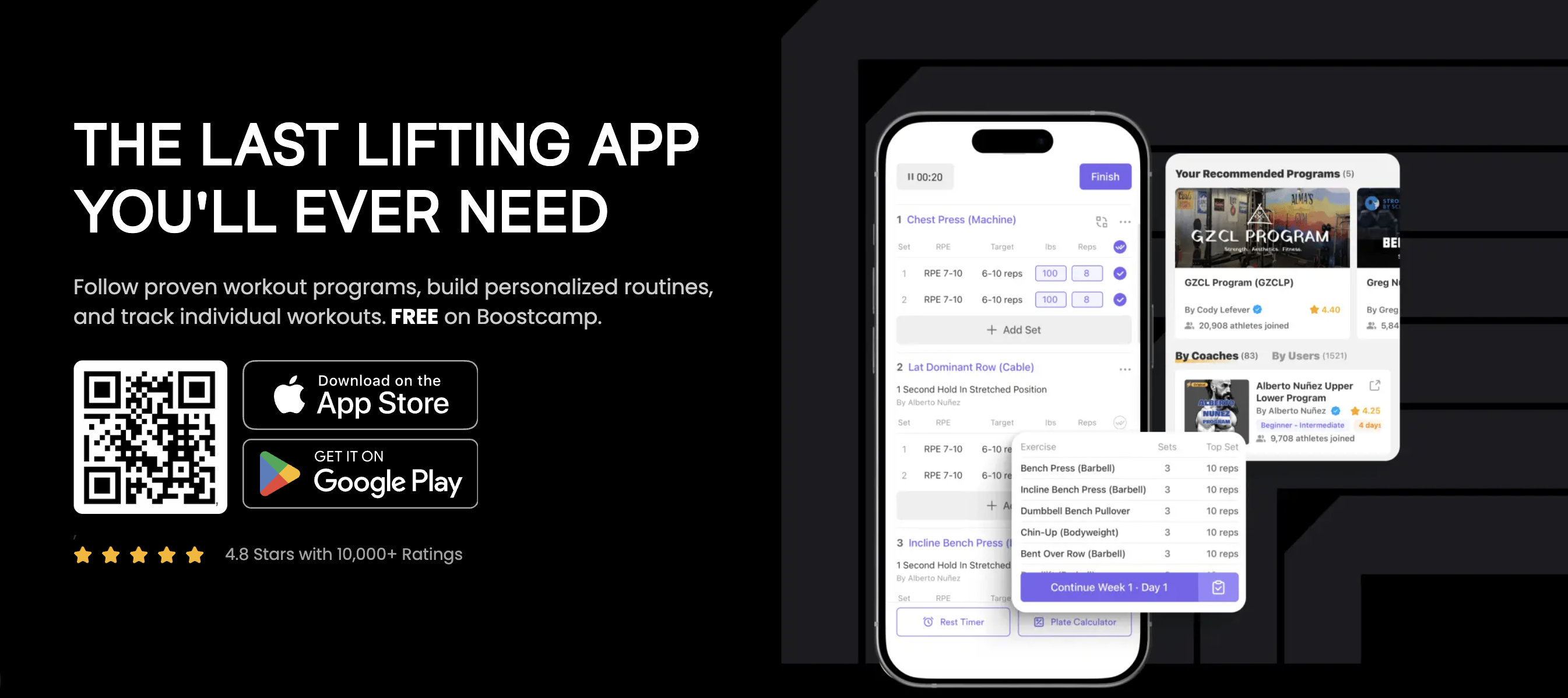Barbell Bicep Curl Guide
Written by The Boostcamp Editors
Build bicep peaks like mountains
The barbell bicep curl is a classic exercise that targets the biceps, helping to develop arm size, definition, and power. By following proper form and utilizing progressive training techniques, you can enhance your curl performance and avoid common mistakes that can lead to injury. Additionally, using a training program like those available on the Boostcamp App allows you to add structure to your workout, maximizing your progress with strategic, science-backed routines.
Our team at Boostcamp has put together a detailed guide on how to perform the barbell bicep curl effectively.
How to Perform the Barbell Bicep Curl
1. Setting Up
Choose the Right Weight: Begin with a manageable weight that allows you to maintain proper form for the entire set. As you progress, you can increase the weight gradually.
Grip the Bar: Grip the barbell with your hands shoulder-width apart and your palms facing up (underhand grip). Make sure to keep a firm grip to maintain control throughout the movement.
Elbow Position: Keep your elbows close to your torso and in a fixed position. Avoid letting them move forward or backward, as this can reduce the effectiveness of the curl and place unnecessary strain on your shoulders.
2. Body Position
Stand Tall: Keep your feet about hip-width apart, with your knees slightly bent to help you stabilize your position. Stand upright with your shoulders pulled back and down, avoiding any slouching or leaning forward.
Brace Your Core: Engage your core muscles to create a stable base, which helps prevent swinging or unnecessary movement that could compromise your form and reduce the impact on your biceps.
Maintain a Neutral Spine: A straight back is essential to maintaining stability and balance. Avoid arching or rounding your lower back during the curl.
3. Lifting the Bar
Curl the Bar Upward: Begin by bending at the elbows, lifting the bar in a controlled arc towards your shoulders. Your biceps should be doing the work, so focus on squeezing them as you lift, this is where the mind-muscle connection is absolutely essential.
Avoid Using Momentum: Keep the movement smooth and avoid using your body or shoulders to “swing” the weight up. Relying on momentum takes the tension off the biceps, reducing the effectiveness of the exercise.
Full Range of Motion: Lift until your biceps are fully contracted, with the bar close to your shoulders. This ensures you’re targeting the muscle effectively and maximizing each rep.
4. At the Top
Squeeze the Biceps: At the top of the movement, squeeze your biceps tightly to increase the contraction. This brief hold maximizes muscle engagement and control.
Avoid Overextending Wrists: Keep your wrists neutral, not allowing them to curl forward or backward, which can strain your forearm and wrist muscles.
5. Lowering the Bar
Control the Descent: Slowly lower the bar back down to the starting position, maintaining control. Lowering the weight too quickly can lead to injury and decreases the time under tension, which is important for muscle growth.
Maintain Tension: Keep your biceps engaged throughout the descent, not letting them relax fully until you reach the bottom of the movement. This helps you maintain tension in the muscle, promoting strength gains and muscle growth.
Using Boostcamp to Find Workout Programs

Boostcamp offers plenty of free training programs that are written by renowned coaches, and can focus on arm and bicep development through a variety of exercises, including barbell curls.
Using these programs can help you progress consistently and safely. Here’s how Boostcamp can boost your bicep training:
Access Structured Programs: Boostcamp features programs that incorporate heavy arm focus, using exercises like barbell curls with progressive overload, allowing you to build strength gradually. This approach minimizes the risk of injury while maximizing gains.
Track Your Progress Easily: With Boostcamp’s workout tracker, you can log each set, weight, and rep with Boostcamp’s tracking features, helping you to monitor your improvement over time and adjust based on your progress.
Enhance with Accessory Exercises: Many Boostcamp programs include complementary exercises, such as hammer curls, preacher curls, or tricep work, which help balance your arm strength and target different areas of the biceps and forearms.
Stay Consistent and Motivated: By following Boostcamp’s organized workout plans, you’re more likely to stick with a routine, which is crucial for long-term strength gains and muscle growth.
Learn from Experts: Boostcamp programs are designed by experienced coaches who provide guidance on form, volume, and frequency, so you can train with confidence.
Tips for Barbell Bicep Curl Success
Focus on Mind-Muscle Connection: Concentrate on feeling your biceps work during each curl. This “mind-muscle connection” can increase activation and improve muscle engagement.
Warm Up Thoroughly: Use lighter weights or resistance bands for warm-ups to get blood flowing to your arms and prevent injury.
Avoid Excessive Weight: Choose a weight you can lift with good form, focusing on bicep engagement instead of loading up heavy weights. Control and consistency will build strength more effectively.
Incorporate Slow Negatives: Take 3–4 seconds to lower the bar on some sets to increase time under tension, which can be highly effective for muscle growth.
Rest and Recover: The biceps are a smaller muscle group and can be overtrained easily. Aim for 1–2 bicep-focused workouts per week, with adequate rest days in between.
Barbell Bicep Curl Wrap Up
When performed correctly, the barbell bicep curl is an excellent exercise for building bicep strength and size. Combine this exercise with a structured Boostcamp program, and you’ll be able to track your progress while enhancing your overall strength and form. Train consistently, focus on technique, and enjoy seeing your arms grow stronger!
Let us know! And be sure to follow Boostcamp on Instagram and subscribe on YouTube!

HEADER IMAGE COURTESY OF STEEL SUPPLEMENTS

